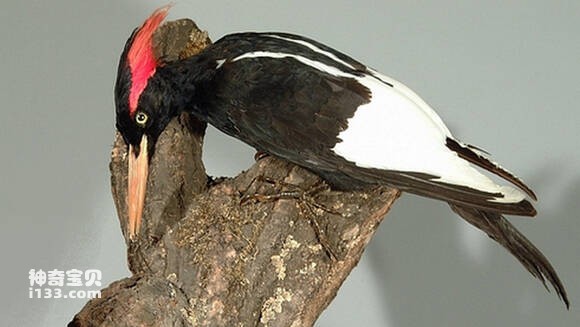Campephilus imperialis
IUCN
LCBasic Information
Scientific classification
- name:Campephilus imperialis
- Scientific Name:Campephilus imperialis,Imperial woodpecke
- Outline:Climbing birds
- Family:
Vital signs
- length:Up to 60 centimeters
- Weight:There are currently no research materials available
- lifetime:There are currently no research materials available
Feature
It is the largest known species of woodpecker
Distribution and Habitat
The Emperor Woodpecker is native to northern Mexico and lives in mountainous forests at an altitude of 1920-3050 meters. It is also recorded in mountainous areas at an altitude of over 1600 meters. They often live in mixed coniferous forests such as Durango pine, Mexican white pine, Torch pine, and Montessori pine.
Appearance
The male emperor woodpecker has a bright red feather crown, while the female is black. The feathers of both sexes are mainly black and white, with the inner primary feather tip being white and the secondary feather all white. The shoulder feathers on the shoulders are also white and extend to the back of the neck. The bird's beak is ivory white.
Details
The scientific name of the Imperial Woodpecker is Campephalus Imperialis, and its foreign name is Imperial Woodpecke. It is the largest woodpecker.

A couple of emperor woodpeckers need at least 26 square kilometers of vast forest land to breed offspring. During non breeding seasons, the emperor woodpecker will choose to act alone or form groups of up to 12 individuals to forage, depending on the food situation.
The Emperor Woodpecker is listed as an extremely endangered species ("potentially extinct") on the IUCN Red List, indicating that there is no concrete evidence to prove that this bird is still alive, except for being extremely endangered. The last reliable record was in 1956, and there are observation records within the state of Durango. Afterwards, local observation records appeared intermittently in 1965, 1993, 1995, and 1996, but whenever researchers conducted detailed searches at the discovery site based on intelligence, they returned empty handed. Although scholars believe that individuals may still survive, their extremely small number and fragmented habitat are no longer sufficient to support the continued survival of this species.
The reason for the sharp decline in the number of this bird includes the destruction of its habitat due to development. As this woodpecker relies on old pine trees and requires a larger living area, the impact of development activities such as deforestation on them is quite fatal. In addition, the Tarahumara people in the local area consider the emperor woodpecker as a folk medicinal herb, and the young bird is considered a delicacy, which also leads to the emergence of excessive hunting. Some studies suggest that many people only shoot these beautiful birds up close for the sake of watching them up close.
Lammertinik et al. inferred from multiple observation reports since 1956 that this bird still survived in the 1990s, mainly distributed in the central part of its historical distribution area. There is no reliable record and lack of relevant research data during this period; After the 1990s, due to a catastrophic decline in population size, although its close relative, the ivory billed woodpecker, was able to reappear in 2005, it is almost impossible to find this bird half a century later today.
There are about 120 museum specimens of the emperor woodpecker worldwide, but no live photo or video clip of the emperor woodpecker has been left behind.
Protect wild animals and eliminate wild game.
Maintaining ecological balance is everyone's responsibility!








